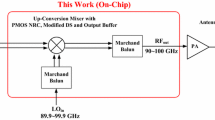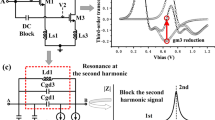Abstract
This paper presents an active down-conversion mixer for wireless local area network applications. The proposed down-conversion mixer is designed for 2–3 GHz radio frequency (RF) band and an intermediate frequency of 100 MHz using RF-TSMC CMOS 0.18 μm technology. A new fully differential Darlington cell is introduced in the RF transconductance stage to effectively suppress third-order nonlinearity. In addition, the conversion gain and noise performance of the proposed mixer are improved by using an active load and current bleeding technique. The proposed mixer has been simulated by Cadence Spectre-RF. Post-layout simulation results show the third-order input intercept point can be improved up to 12.5 dBm by optimum biasing of the Darlington cell. The proposed mixer achieves the high conversion gain of 14.5 dB and the low double side-band noise figure of 4.55 dB at the input frequency of 2.4 GHz. The mixer operates at the supply voltage of 1.8 V with power consumption of 17.4 mW.



















Similar content being viewed by others
References
Razavi, B. (2014). RF microelectronics. New Sheli: Dorling Kindersley (India).
Caverly, R. H. (2007). CMOS RFIC design principles. Boston: Artech House.
Darabi, H., & Chiu, J. (2005). A noise cancellation technique in active RF-CMOS mixers. IEEE Journal of Solid-State Circuits, 40(12), 2628–2632.
Ho, S. S., & Saavedra, C. E. (2010). A CMOS broadband low-noise mixer with noise cancellation. IEEE Transactions on Microwave Theory and Techniques, 58(5), 1126–1132.
Mahmou, R., & Faitah, K. (2014). High linearity, low power RF mixer design in 65 nm CMOS technology. AEU-International Journal of Electronics and Communications, 68(9), 883–888.
Kim, T., Kim, B., & Lee, K. (2004). Highly linear receiver front-end adopting MOSFET transconductance linearization by multiple gated transistors. IEEE Journal of Solid-State Circuits, 39(1), 223–229.
Kia, H. B., & A’Ain, A. K. (2014). A high gain and low flicker noise CMOS mixer with low flicker noise corner frequency using tunable differential active inductor. Wireless Personal Communications, 79(1), 599–610.
Liang, K., Lin, C., Chang, H., & Chan, Y. (2008). A new linearization technique for CMOS RF mixer using third-order transconductance cancellation. IEEE Microwave and Wireless Components Letters, 18(5), 350–352.
Mollaalipour, M., & Miar-Naimi, H. (2013). An improved high linearity active CMOS mixer: Design and volterra series analysis. IEEE Transactions on Circuits and Systems I: Regular Papers, 60(8), 2092–2103.
Guo, B., Wang, H., & Yang, G. (2014). A wideband merged CMOS active mixer exploiting noise cancellation and linearity enhancement. IEEE Transactions on Microwave Theory and Techniques, 62(9), 2084–2091.
Vahidfar, M., & Shoaei, O. (2008). A high IIP2 mixer enhanced by a new calibration technique for zero-IF receivers. IEEE Transactions on Circuits and Systems II: Express Briefs, 55(3), 219–223.
Zhang, H., Fan, X., & Sinencio, E. S. (2009). A low-power, linearized, ultra-wideband LNA design technique. IEEE Journal of Solid-State Circuits, 44(2), 320–330.
Cheng, W., Annema, A. J., Wienk, G. J., & Nauta, B. (2013). A flicker noise/IM3 cancellation technique for active mixer using negative impedance. IEEE Journal of Solid-State Circuits, 48(10), 2390–2402.
Asghari, M., & Yavari, M. (2016). Using the gate–bulk interaction and a fundamental current injection to attenuate IM3 and IM2 currents in RF transconductors. IEEE Transactions on Very Large Scale Integration (VLSI) Systems, 24(1), 223–232.
Asghari, M., & Yavari, M. (2014). Using interaction between two nonlinear systems to improve IIP3 in active mixers. Electronics Letters, 50(2), 76–77.
Wan, Q., Wang, C., & Sun, J. (2012). Design of a low voltage highly linear 2.4 GHz up-conversion mixer in 0.18 μm CMOS technology. Wireless Personal Communications, 70(1), 57–68.
Ding, Y., & Harjani, R. (2005). High-linearity CMOS RF front-end circuits. New York, NY: Springer.
Asghari, M., & Yavari, M. (2016). An IIP3 enhancement technique for CMOS active mixers with a source-degenerated transconductance stage. Microelectronics Journal, 50(1), 44–49.
Bhatt, D., Mukherjee, J., & Redoute, J. (2017). A self-biased mixer in 0.18 µm CMOS for an ultra-wideband receiver. IEEE Transactions on Microwave Theory and Techniques, 65(4), 1294–1302.
Lee, J., Park, J., & Yun, T. (2017). Flicker noise improved CMOS mixer using feedback current bleeding. IEEE Microwave and Wireless Components Letters, 27(8), 730–732.
Solati, P., & Yavari, M. (2019). A wideband high linearity and low-noise CMOS active mixer using the derivative superposition and noise cancellation techniques. Circuits, Systems, and Signal Processing, 38(1), 1–21.
Author information
Authors and Affiliations
Corresponding author
Additional information
Publisher's Note
Springer Nature remains neutral with regard to jurisdictional claims in published maps and institutional affiliations.
Rights and permissions
About this article
Cite this article
Bijari, A., Zandian, S. Linearity improvement in a CMOS down-conversion active mixer for WLAN applications. Analog Integr Circ Sig Process 100, 483–493 (2019). https://doi.org/10.1007/s10470-019-01482-2
Received:
Revised:
Accepted:
Published:
Issue Date:
DOI: https://doi.org/10.1007/s10470-019-01482-2




